- Clone
- 15H2B45 (See other available formats)
- Regulatory Status
- RUO
- Other Names
- Signal transducer and activator of transcription 3, acute-phase response factor (APRF), HIES, ADMIO
- Isotype
- Mouse IgG1, κ
- Ave. Rating
- Submit a Review
- Product Citations
- publications
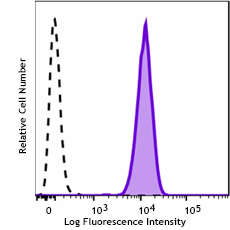
-

HeLa cells were fixed with fixation buffer and permeabilized with True-Phos™ Perm Buffer, and intracellularly stained with anti-human STAT3 (clone 15H2B45) APC (filled histogram) or mouse IgG1, κ APC isotype control (open histogram)
| Cat # | Size | Price | Quantity Check Availability | Save | ||
|---|---|---|---|---|---|---|
| 371805 | 25 tests | 116€ | ||||
| 371806 | 100 tests | 284€ | ||||
STAT3 is an 88 kD member of the STAT (signal transducer and activators of transcription) protein family that is phosphorylated in response to cytokine receptor-associated kinase activity. Phosphorylation of STAT3 induces nuclear translocation to activate transcription. STAT3 forms both homo- and heterotrimers and is involved in the activation of genes required for cell growth and apoptosis. STAT3 is also involved in gp130 signaling and binds to IL-6 response elements in various acute phase protein promoters. STAT3 is phosphorylated by signaling from IFNs, EGF, FGF, IL-5, HGF, LIF, and BMP2. STAT3 activity is inhibited by PIAS3 and GRIM-19 and can also be regulated by Rac1 protein.
Product DetailsProduct Details
- Verified Reactivity
- Human
- Antibody Type
- Monoclonal
- Host Species
- Mouse
- Immunogen
- Partial human STAT3 recombinant protein (621-770 a.a.) expressed in E. coli.
- Formulation
- Phosphate-buffered solution, pH 7.2, containing 0.09% sodium azide and BSA (origin USA)
- Preparation
- The antibody was purified by affinity chromatography and conjugated with APC under optimal conditions.
- Concentration
- Lot-specific (to obtain lot-specific concentration and expiration, please enter the lot number in our Certificate of Analysis online tool.)
- Storage & Handling
- The antibody solution should be stored undiluted between 2°C and 8°C, and protected from prolonged exposure to light. Do not freeze.
- Application
-
ICFC - Quality tested
- Recommended Usage
-
Each lot of this antibody is quality control tested by intracellular immunofluorescent staining with flow cytometric analysis. For flow cytometric staining, the suggested use of this reagent is 5 µL per million cells in 100 µL staining volume or 5 µL per 100 µL of whole blood. It is recommended that the reagent be titrated for optimal performance for each application.
- Excitation Laser
-
Red Laser (633 nm)
- Application Notes
-
Clone 15H2B45 blocks clone 4G4B45.
- RRID
-
AB_2927833 (BioLegend Cat. No. 371805)
AB_2927833 (BioLegend Cat. No. 371806)
Antigen Details
- Structure
- 770 amino acids with a predicted molecular weight of 88.1 kD. Contains a C-terminal SH2 domain responsible for homo- or heterodimerization.
- Distribution
-
Phosphorylated in response to cytokine signaling by receptor-associated kinases; translocates to nucleus to act as transcriptional activator. Activates a wide variety of genes involved in cell growth and apoptosis, involved in gp130-related signaling.
- Function
- Cytoplasm.
- Interaction
- STAT3 forms a homodimer or a heterodimer with other STAT family members. Interacts with IL31RA, NCOA1, PELP1, SIPAR, SOCS7, STATIP1, CAV2, DAPK3, EIF2AK2, PIAS3, and TMF1.
- Cell Type
- Embryonic Stem Cells, Mesenchymal Stem Cells
- Biology Area
- Cell Biology, Neuroscience, Neuroscience Cell Markers, Stem Cells, Transcription Factors
- Molecular Family
- Nuclear Markers
- Antigen References
-
1. Lufei C, et al. 2003. EMBO J. 22:1325.
2. Deo D, et al. 2002. J. Biol. Chem. 277:21237.
3. Pfeffer L, et al. 1997. Science. 276:1418.
4. Akira S, et al. 1994. Cell. 77:63. - Gene ID
- 6774 View all products for this Gene ID
- UniProt
- View information about STAT3 on UniProt.org
Related FAQs
Other Formats
View All STAT3 Reagents Request Custom Conjugation| Description | Clone | Applications |
|---|---|---|
| Purified anti-human STAT3 | 15H2B45 | ICFC |
| PE anti-human STAT3 | 15H2B45 | ICFC |
| APC anti-human STAT3 | 15H2B45 | ICFC |
Customers Also Purchased
Compare Data Across All Formats
This data display is provided for general comparisons between formats.
Your actual data may vary due to variations in samples, target cells, instruments and their settings, staining conditions, and other factors.
If you need assistance with selecting the best format contact our expert technical support team.
-
Purified anti-human STAT3
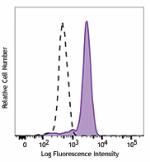
HeLa cells (filled histogram) or PC-3 cells (open histogram)... -
PE anti-human STAT3
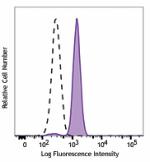
HeLa cells (filled histogram) or PC-3 cells (open histogram)... -
APC anti-human STAT3
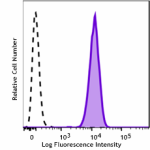
HeLa cells were fixed with fixation buffer and permeabilized...
 Login / Register
Login / Register 









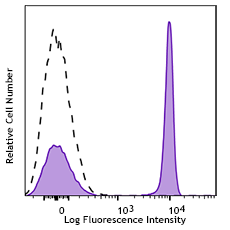
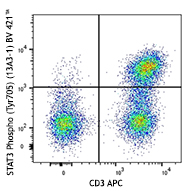
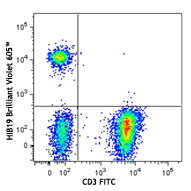
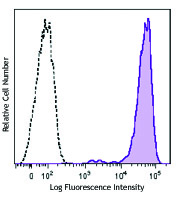



Follow Us